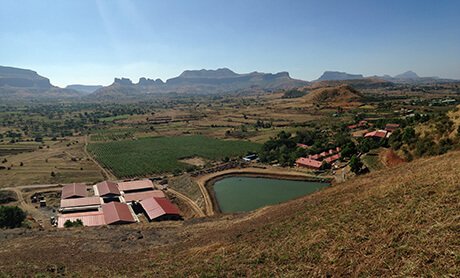In the syllabus of Yoga Pravesh, one Upasana Program was included. It contained Japa (continuous recitation) of Om as the study of the Dhyana Process. If we study Ashtang Yoga, it is seen that Dhyana as a process comes later in the study. Dharana comes before Dhyana process. Yoga Pravesh syllabus did not cover a thorough study of Yoga and as such the word Dhyana was used only as a popular term. In fact, though termed as Dhyana, it was just a stage, which comes even before Dharana.
In this syllabus, we will study the process of Dharana as described by Patanjali. However, before doing so, it is advisable to go through the chapter of Prarthana and Dhyana in the Yoga Pravesh text.
While describing the eight aspects (angas) of Ashtang Yoga, Patanjali has stated Dharana, Dhyana and Samadhi as the last three aspects. It is also stated by him that all the three aspects are collectively termed as " Sanyam" (Control). This implies that all the three aspects should be considered together. We should also bear in mind while studying that Dharana, Dhyana and Samadhi are progressively advanced stages of concentration. The highest stage of mental concentration described by the modern psychologists is more or less similar to the description of Dharana i.e. the primary stage of concentration as described by Patanjali. This indicates the thoughtfulness of Patanjali while describing the three stages.
Another characteristic of these three stages is that there is no dividing line in between these stages. When certain progress is made in the studies of Dharana, Dhyana stage is automatically entered into and with the progress in Dharana stage, Sadhaka automatically enters in the Samadhi stage. The three stages mingle into each other as easily as three colours are mixed into each other on the canvass of an artist. During this syllabus we will not study all the three stages. We will consider only the first stage Dharana. We had studied this topic generally during the Yoga Pravesh syllabus. Now we will study Dharana as an independent process.
Deshbandhas chittasya dharana | P Y S 3-
Patanjali has stated this definition of Dharana. The natural meaning of this sutra is "Deshbandh of chitta is Dharana". Chitta i e the mind is extremely wavering; to engage it in a particular area is Dharana. The mind will be free within the periphery of this area, but it should not cross the boundary. This exercise is known as Dharana.
To understand this definition an example can be cited :
A farmer owns a calf. The calf wants to roam around in different directions. To control the calf from such wandering in different directions, it is not possible to tie it up to a particular point. So the farmer ties a cord of certain length to its neck and then ties the other end of the cord to a hook in the ground. The calf can freely move in the circle, the radius being the length of the cord, but it cannot go out of that circle. Thus the farmer has a control on the calf and also the calf is not at a disadvantage either, as it gains a controlled freedom. This attitude and the idea is important. The mind, which is just like the calf wants to roam around everywhere. It is not possible to engage it at a particular point or location. Hence, Patanjali states the preliminary process of Dharana, a primary step in the lengthy process of controlling the mind. The restriction put on the mind is known as "Alamban". With the help of the "Alamban", the mind is fixed and engaged in a particular area. The restriction can be anything. We will see the restriction or "Alamban" of Om. We have earlier studied the japa of Om, so we can move further in the same direction.
The study of Dharana is the study of concentration of mind. Hence, certain preliminary preparations are necessary. We get various perceptions, through the five sensory organs. The mind usually runs behind such sensory perceptions. To stabilise the mind, attention has to be paid as to how these perceptions can be reduced. The surroundings should be pleasurable to the mind and not troublesome. There should not be any external disturbances. The general chaos, other sounds, strong breeze, different smells, extremely bright light are various disturbances that should be avoided. When these are removed, the causes, which seek the attention of the mind, get reduced. Then one should sit on a comfortable seat in a pose conducive to Dhyana such as Padmasan, Swatikasan or Siddhasan. One should have the practice of sitting firmly, yet comfortably in a particular pose for a longer duration. Otherwise, the mind will get diverted towards the signals from various muscles. The pose should be "samkay shirogreevam" and the eyes should be fixed on the picture of Om in the front. The picture should be at the eye level and placed under sufficient light. Whenever the eyes try to avert itself beyond the picture, an effort should be made to lock it on the picture again. The mind generally follows the eyesight, so fixing of the gaze will result in locking the mind too. Start the Japa of Om with calm attitude. The way with which the sound of Om is emitted through the mouth should be gradual and effective. The vocal cords or the lungs should not feel strained while doing the japa. (the ideal method of the pronunciation should be learnt from the experts). As the tongue is engaged in the japa of Om, the mind will follow the tongue and will restrict its movement towards Om. The japa is automatically heard by the ears and as such again felt by the mind. Thus, the mind will be firmly kept onto the Om.
Out of five sensory organs, the eyes, the tongue and the ears are concentrating on only one subject of Om, so the mind, which runs after the sensory perceptions, will also be firmly engaged on Om. Here, Om is an "alamban" and the dimension covered by Om is the restricted area in which the mind can move (deshbandh). After some period, stop the japa, close the eyes and try to concentrate the mind on the memories of Om sensed through the gaze, the tongue and the ears. This experience transcends the sensory organs and the engagement of mind in this is the real dharana. While practising this, the mind may sway beyond the experience towards other things. This discontinues the dharana. Then the mind has to be brought again into the experience. There will be several disturbances; however with practice, they get reduced. The concentration without any disturbances is dharana. In that stage, there is no other experience than the "Alamban". It is a soothing, pleasurable stage giving intense satisfaction and peace of mind. When Dharana is practised for half an hour or so, the stage is experienced only for a few minutes, the other moments spent in controlling the wandering mind. However, with continuous practice, the duration of the pleasurable stage increases and the sadhaka becomes prepared to enter into the next stage. With further practice, the area of the "alamban" or its limits is to be reduced. With the reduction of the area, the dharana will be more effective and the sadhaka will get nearer to the next stage of dhyana.
One can select any other alamban other than the dhyana. This "Alamban" should be the subject of gaze, tongue and the ears like Om. "Alamban", which can be the subject of these sensory perceptions, is better. If the "Alamban" is subject of only one sensory organ, then the other organs will choose their own subjects and try to pull the mind towards them. This will make mind unsteady further. All this should be considered while choosing the subject of the "alamban".
Patanjali has suggested that Dharana, Dhyana and Samadhi should be considered together and not independently. Hence, while enumerating the results, the results of dharana are not stated separately, but the result of all the three are given together. However, he has clarified that the effects will depend on the "Alamban" too, with the examples of different "Alamban". As the topic is not covered in this syllabus, it is not discussed further over here.
However, we can experience the effect of Dharana from the practical angle. Dharana is the stage of high concentration of the mind. The modern psychologists have described the highest stage of concentration of the human mind, which is similar to that in dharana. It means that the highest level indicated by the psychologists is the first step of concentration of mind as viewed by Patanjali. Dhyana and Samadhi are stages after this.
Dharana affects and reduces the occupied mind. Hence, the disadvantages of such occupied mind also get reduced. The mind is kept firm at one place instead of letting it wander here and there. This reduces strain on the mind. The mental strength increases. With such habitual concentration, the work is done effectively and efficiently. The daily practice of dharana reduces the wavering attitude of mind and a different kind of peace can be observed throughout the day.
An effort is made over here to suggest the direction of the studies of dharana. The description does not cover the study of dharana in entirety. The study and progress depends on the individual strength of each sadhaka. A common education cannot be imparted of such advanced study. After one tries to study and practise, the guidance can be given individually depending upon the disturbances faced, the experiences observed and after judging the progress. This information cannot cover all these aspects.
However, for the students, wherein they study different aspects of yoga alongwith dharana, this much guidance is enough. A daily study and practice is not expected of them. Practice once a week is enough for them. However, those who want to progress in the matter, should start practising daily under the guidance of an expert guru.
Phone - +91-9822770727
E-mail - yoga@yogapoint.com or yogapoint108@gmail.com

Yoga Vidya Dham, Kaivalya Nagari,
College Road, Nashik - 422005.
Maharashtra, India.
Phone - +91-9822770727 (for courses in ENGLISH)
+91-253-2318090 (For courses, in HINDI or MARATHI)
(Please call during 9.00 AM to 5 PM Indian Time)
E-mail - yoga@yogapoint.co or yogapoint108@gmail.com
Village Talwade, Trimbak, Nasik
Maharashtra,India.
Phone - +91-9822770727
E-mail - yoga@yogapoint.com or yogapoint108@gmail.com
